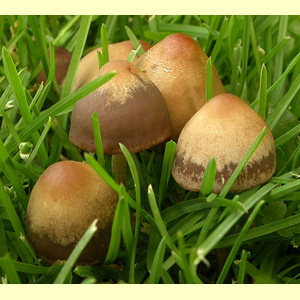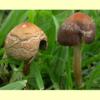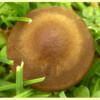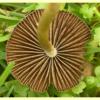
images/Panaeolina_foenisecii/Panaeolina-TM_DSCN0644.jpg
Small agaric, growing on the ground (in lawns), with a dark brown to purple-brown spore print. Pileus brown, not viscid, hygrophanous. Lamellae adnate. Stipe central. Partial veil remnants absent. Spores reddish brown or brown, warty; germ pore broad. Cheilocystidia present. Lamellar trama regular. Pileipellis a hymeniderm; composed of globose to ellipsoid or sometimes broadly clavate elements. Clamp connections present or absent.
Similar to
Panaeolus, from which it differs in having warty spores and the absence of pileocystidia; in addition
Panaeolina is always associated with grass (usually in lawns) and does not grow on dung, as is common in
Panaeolus. Another difference between
Panaeolina and
Panaeolus is spore print colour: dark brown or purplish brown in the former but black or rarely purplish brown in the latter. Fruit-bodies of
Psathyrella can be similarly coloured, hygrophanous, and grow in lawns, but this genus has smooth spores.
Lacrymaria has ornamented spores and a pileipellis composed of rounded elements, but the pileus surface is coarsely fibrillose.
Agrocybe,
Bolbitius and
Conocybe, which can all grow in lawns, share the hymeniderm pileipellis, but all have smooth spores.
Panaeolina Maire, Treb. Mus. Ci. Nat. Barcelona, sér. bot. 2, 15: 109 (1933).
One species:
Panaeolina foenisecii (=
Panaeolus).
Panaeolina foenisecii (Pers. : Fr.) Maire, Treb. Mus. Ci. Nat. Barcelona, sér. bot. 2, 15: 109 (1933).
W.A., S.A., Qld, N.S.W. and Vic. (and probably also N.T. and Tas.).
In lawns in parks and gardens.
On the ground.
Saprotrophic.
Breitenbach, J. & Kranzlin, F. (eds) (1995),
Fungi of Swizerland. Volume 4. Agarics 2nd part. Edition Mykologia, Lucerne. [
Description,
Illustration and
Microcharacters of
P. foenisecii (as
Panaeolus) from Europe]
Fuhrer, B. (2005), A Field Guide to Australian Fungi. Bloomings Books, Hawthorn. [Description and Illustration of P. foenisecii]
Gerhardt, E. (1996), Taxonomische Revision der Gattungen Panaeolus und Panaeolina (Fungi, Agaricales, Coprinaceae), Bibliotheca Botanica, Heft 147, E. Schweizetbart'sche Verlagsbuchhandlung, Stuttgart. [Description and Microcharacters of P. foenisecii]
Southcott, R.V. (1974), Notes on some poisonings and other clinical effects following ingestion of Australian fungi, S. Austral. Clinics 6: 441–478. [Illustration of P. foenisecii and discussion of possible poisoning symptoms]
Watling, R. & Gregory, N. (1987), British Fungus Flora. Agarics and Boleti. 5 / Strophariaceae & Coprinaceae p.p. Hypholoma, Melanotus, Psilocybe, Stropharia, Lacrymaria & Panaeolus. Royal Botanic Garden, Edinburgh. [Description, B&W Illustration and Microcharacters of P. foenisecii (as Panaeolus)]
Young, A.M. (1989a), The Panaeoloideae (Fungi, Basidiomycetes) of Australia, Austral. Syst. Bot. 2: 75–97. [Description, B&W Illustration and Microcharacters of P. foenisecii]
Young, T. (1997b), Panaeolina, Panaeolus and Copelandia, in C.A. Grgurinovic, Larger Fungi of South Australia, 480–490. The Botanic Gardens of Adelaide and State Herbarium and The Flora and Fauna of South Australia Handbooks Committee, Adelaide. [Description and Microcharacters of P. foenisecii]
Young, A.M. (2005b), A Field Guide to the Fungi of Australia. University of New South Wales Press, Sydney. [Description and B&W Illustration of P. foenisecii (as Panaeolus)]





_AL_16_sml.jpg)
